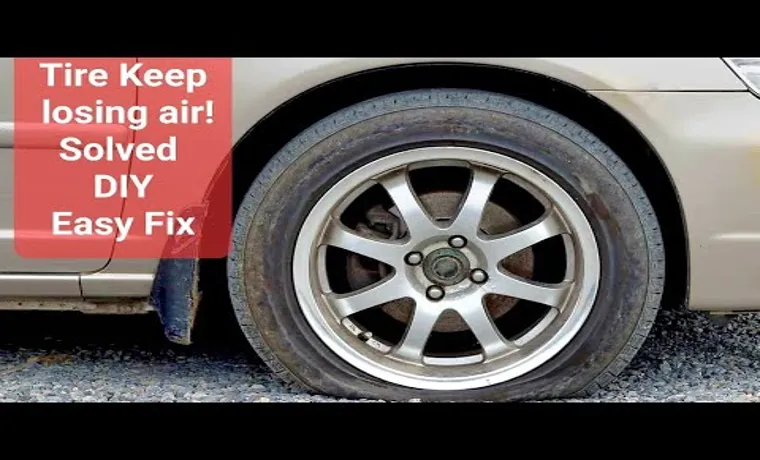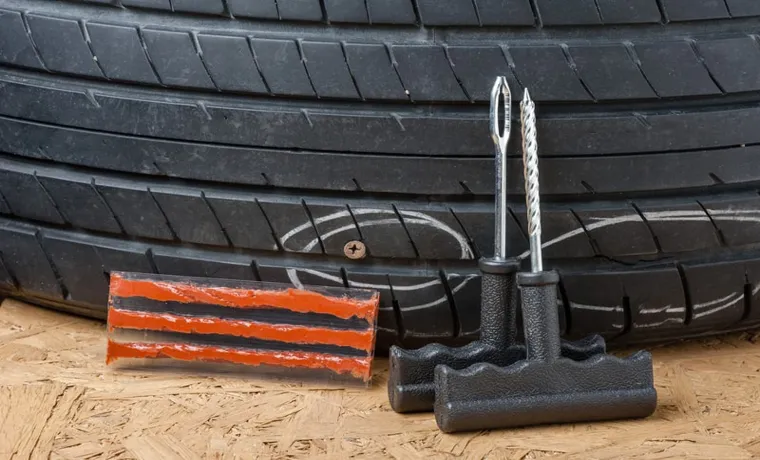Have you ever experienced the frustration of constantly having to fill up your tire with air? It’s a common problem that many drivers face, and can be caused by a variety of issues such as a puncture, a damaged valve, or even just a slow leak. Whatever the cause may be, it’s important to know how to fix a tire that keeps losing air to avoid bigger problems down the road. Think of it like having a small crack in your dam – if left unattended, it can lead to a much bigger disaster.
So let’s dive into some tips and tricks for fixing your tire and getting you back on the road with confidence.
Table of Contents
Identifying the Cause
If you’re dealing with a tire that keeps losing air, identifying the cause is the first step in fixing the problem. There could be several reasons why your tire is losing air, such as a puncture, damage to the valve stem, or a crack in the wheel rim. A simple visual inspection of the tire can often reveal the issue, but sometimes, the problem may be harder to spot.
In such cases, you might need to take the tire off the wheel and check it more thoroughly. Once you’ve identified the cause, you can decide on the best course of action. If the damage is minor, such as a small puncture, you might be able to fix the issue with a patch or sealant.
However, if the problem is more significant or the damage is extensive, you may need to replace the tire altogether. Either way, it’s crucial to address the issue promptly to prevent further damage or even a blowout while driving.
Inspect the Tire for Damage
When inspecting a tire for damage, the first step is identifying the cause. Is it a puncture from a sharp object on the road, or is it due to wear and tear? In some cases, it could be a result of an alignment issue or a problem with the suspension system. It’s essential to figure out the cause to prevent future damage and ensure the safety of the driver and passengers.
One way to identify the cause of tire damage is to look at the location of the puncture. If it’s on the sidewall, it’s likely caused by hitting a curb or other object. If it’s on the tread, it could be due to a puncture or embedded object.
If the tire is worn unevenly, it could be due to a misalignment issue or worn suspension components. Another thing to consider when inspecting tires is the age of the tire. Over time, tires can dry out and crack, which can lead to blowouts.
It’s recommended to replace tires every six years, even if they look fine. By identifying the cause of tire damage, you can take steps to prevent it from happening again. If it’s due to hitting an object on the road, be more cautious while driving, especially on rough roads.
If it’s due to misalignment or worn suspension components, get your vehicle checked by a mechanic. Taking care of your tires is essential for the safety of everyone on the road.

Check Valve Stem for Leaks
Check valve stem for leaks can be a daunting task that requires precision and attention to detail. Identifying the cause of the leak is the first step in fixing the issue. Common causes of leaks in the valve stem include worn out seals, debris clogging the valve, or damage to the valve itself.
In some cases, the valve stem may also be damaged due to mishandling or exposure to harsh substances. As a result, it is essential to carefully inspect the valve stem for any visible signs of damage or wear. By taking the necessary precautions and addressing the problem promptly, one can prevent potential damage to the valve or system and ensure safe and efficient operation.
Search for Punctures or Nails
When you notice your tire has gone flat, the first thing you need to do is figure out the cause. One of the most common reasons for a flat tire is a puncture or a nail that has become embedded in the rubber. To find the source of the problem, you’ll need to inspect the tire thoroughly.
Look for any visible signs of damage or foreign objects that may have caused the puncture or nail. You may need to remove the tire from the rim and examine both sides to ensure you don’t miss anything. Using a flashlight can be helpful if the puncture is hard to spot.
Once you have identified the source of the issue, you can determine whether the tire is repairable or needs to be replaced. It’s always better to be safe than sorry when it comes to tires, so don’t ignore the warning signs. A small puncture could quickly lead to a larger problem if left unchecked, so make sure you deal with the issue as soon as possible.
Repairing the Tire
If you’re dealing with a tire that keeps losing air, it’s important to take action before you get stranded on the road. First, you need to identify the problem. Is it a puncture or a leak? You can do this by spraying soapy water on the tire and observing where bubbles form.
If it’s a small puncture, you can try using a tire plug kit. Simply insert the plug into the puncture and inflate the tire. If it’s a larger hole or a leak somewhere else, you may need to replace the tire or take it to a professional.
It’s also important to check the tire pressure regularly to avoid any safety issues. By taking care of your tires, you can save yourself from a lot of headaches down the road.
Plug the Hole with a Tire Plug Kit
If you’re out on the road and suddenly find yourself with a flat tire, don’t panic! With the right tire plug kit, you can easily repair your tire and get back on the road in no time. These kits typically include everything you need to plug the hole in your tire, including a reaming tool to prepare the puncture site, a plug insertion tool to place the plug into the hole, and rubber plugs to fill the hole and hold the air inside the tire. Repairing a tire with such a kit is a quick and affordable solution that can save you both time and money compared to replacing the tire or calling for a tow truck.
So, next time you find yourself with a flat tire, remember that plugging the hole with a tire plug kit is a simple fix that anyone can do, and get back on the road with confidence.
Patch the Tire from the Inside
When it comes to repairing a tire, it’s important to patch it from the inside. This ensures that the repair is secure and long-lasting. Simply plugging the hole from the outside may seem like an easy fix, but it doesn’t address the potential damage on the inside of the tire.
By patching from the inside, the repair covers the damaged area completely, preventing any further air loss or potential blowouts. It’s a simple process, but it’s important to have the right tools and materials to ensure a proper repair. Whether you take your tire to a professional or do it yourself, make sure you patch the tire from the inside for a secure and reliable repair.
Preventing Future Air Loss
When you have a tire that keeps losing air, it can be frustrating. Not only does it mean you have to continually refill your tire, but it can also be a sign of a more significant issue. The first step in fixing this problem is to identify where the air loss is coming from.
This can be done by fully inflating the tire, spraying a mixture of dish soap and water over the tire, and looking for bubbles where the air is escaping. Once you’ve identified the problem, you can then proceed to fix it, whether it’s through patching a small hole or replacing the tire entirely. However, to prevent this problem from happening in the future, it’s essential to practice good tire maintenance.
This includes regularly checking your tire pressure, rotating your tires, and avoiding driving on rough terrain or over curbs. By taking these steps, you can ensure that your tires stay in good condition, and you don’t have to deal with the frustration of continually losing air.
Proper Tire Pressure Maintenance
Proper tire pressure maintenance is essential for the longevity and reliability of your vehicle. A common issue faced by many car owners is sudden air loss. This could be due to a variety of reasons, such as punctured tires or worn-out valve stems.
However, with proper maintenance, you can prevent such issues in the future. One simple solution is to check your tire pressure regularly using a tire pressure gauge. This will allow you to detect any loss in air pressure and take prompt action.
Additionally, make sure to replace your valve stems every few years to prevent them from wearing out and causing air leakage. By taking these simple steps, you can ensure that your tires remain in good condition and your drives are safe and smooth.
Avoiding Road Hazards and Obstacles
When driving, encountering road hazards and obstacles is inevitable. However, maneuvering your vehicle to avoid these obstacles is essential to prevent future air loss. Road hazards like potholes, debris, and uneven surfaces can cause damage to your tires, eventually leading to air loss.
To prevent this from happening, it’s crucial to keep your eyes focused on the road and watch out for any potential hazards ahead of you. If you see something obstructing the way, try to steer clear of it or slow down to avoid a collision. It’s also important to keep your tires inflated to the manufacturer’s recommended pressure, as under-inflated tires are more prone to damage.
In addition, regularly checking the treads on your tires can alert you to any potential issues before they become a major problem. Remember, preventing road hazards and obstacles is key to maintaining safe and efficient driving, and protecting your tires from air loss.
Conclusion
In conclusion, fixing a tire that keeps losing air can be a frustrating experience. It always seems to happen at the most inconvenient times, like when you’re in a hurry or just about to hit the road for a long trip. But fear not, with the right tools and a little bit of know-how, you can easily get back on the road in no time.
Whether it’s a simple puncture or a more complex issue, take the time to assess the situation and find the root cause of the problem. From there, follow these steps to get your tire back in top shape: patch the hole, replace the valve stem, check the surrounding area for any signs of wear or damage, and double-check your tire pressure. And remember, when it comes to fixing a tire, time is of the essence – so don’t hesitate to take action and get your ride back on track.
Happy driving!”
FAQs
What are the common causes of a tire that keeps losing air?
The common causes of a tire that keeps losing air include punctures, worn out valve stems, damaged rims, and improper tire installation.
How do I check for a leak in my tire?
You can check for a leak in your tire by using a spray bottle with soapy water and spraying it on your tire’s valve stem, bead, and tread area. If there is a leak, you will see bubbles forming.
Can I repair a tire that keeps losing air?
It depends on the cause of the leak. If it is a small puncture on the tread area, you can repair it with a tire patch. However, if the leak is caused by a damaged sidewall or worn out valve stem, you may need to replace the tire.
How often should I check my tire pressure to avoid a tire that keeps losing air?
It is recommended to check your tire pressure at least once a month or before a long trip. This helps maintain optimal tire pressure and prevents a tire that keeps losing air.
How do I properly inflate my tire to prevent it from losing air?
You can use a tire pressure gauge to measure the tire pressure and then add or release air accordingly. Be sure to inflate to the manufacturer’s recommended pressure, which is usually found on the side of the tire.
Can extreme temperatures cause a tire that keeps losing air?
Yes, extreme temperatures can cause a tire that keeps losing air. High temperatures can cause the air in the tire to expand, while low temperatures can cause it to contract, leading to a loss of pressure.
Do I need to replace all four tires if one keeps losing air?
It depends on the severity and cause of the leak. If the tire is repaired or replaced promptly, you may not need to replace all four tires. However, if the tire is severely damaged or old, it is recommended to replace all four tires for optimal safety and performance.


